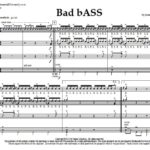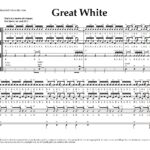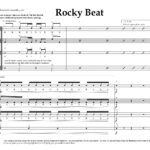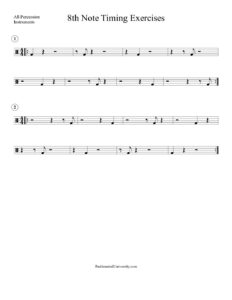A new cadence section has been created in the Free Stuff section at the top of the page. Check out these new cadences posted for your listening and playing enjoyment. More will be added in the future, but here are three to get you started.
Some of the cadences are free, and some of them cost a little bit. Overall, we want to keep these affordable and accessible for any drum line that wants to play them. Generally speaking, the free ones have a simple structure and are just fun to play. The ones available for purchase are a little more involved and took more effort to create. If you like this site and the music, please consider supporting it through purchasing one of the cadences. Thanks!
Great White – FREE
Difficulty: 2.5 – This catchy cadence gets faster and faster on each repetition. This requires some control on accented singles, 6-stroke rolls, and syncopated 16th note rhythms. It should be accessible for an average high school or good junior high drum line.
Click here to download as a PDF.
Rocky Beat – FREE
Difficulty: 1.5 – This simple cadence consists of a three-measure groove followed by a four-count solo, each time performed by a different drum line member. The solos here are just examples. They can be easy or difficult. It’s a fun opportunity to show off some improvisation and creativity! The snare line needs to be able to play a basic rock groove, which requires a little bit of independence coordination between each hand, but it should be fairly quick to learn for most percussionists who have been playing for at least a year. This cadence should be accessible for an average junior high drum line. (A high school can also have fun with it by making the solos flashier and harder!)
Click here to download as a PDF.
Bad bASS – $4.97

Difficulty: 4.5 – You may recognize this cadence as the “soundtrack” for many other videos on this site. It starts confidently with a hard-thumping bass groove and showcases some fun feature moments for every section. The snare and tenors need to be able to play their flam rudiments. Flam taps, pataflaflas, and flamacues are just some of the rudiments you’ll encounter. The bass line has split 16th note triplets and 32nd notes, some syncopated 16th notes splits, and double stroke rolls in the top two parts. The recording features five bass drums, but an alternative four-bass part is included with the purchase. (If you have six bass drums, just double the bottom part.) The cymbal part is written for two or more players, but one person can combine the parts if needed. This cadence has drive. It has attitude. It’s bad a$$. This cadence should be accessible for an average college or good high school line.



